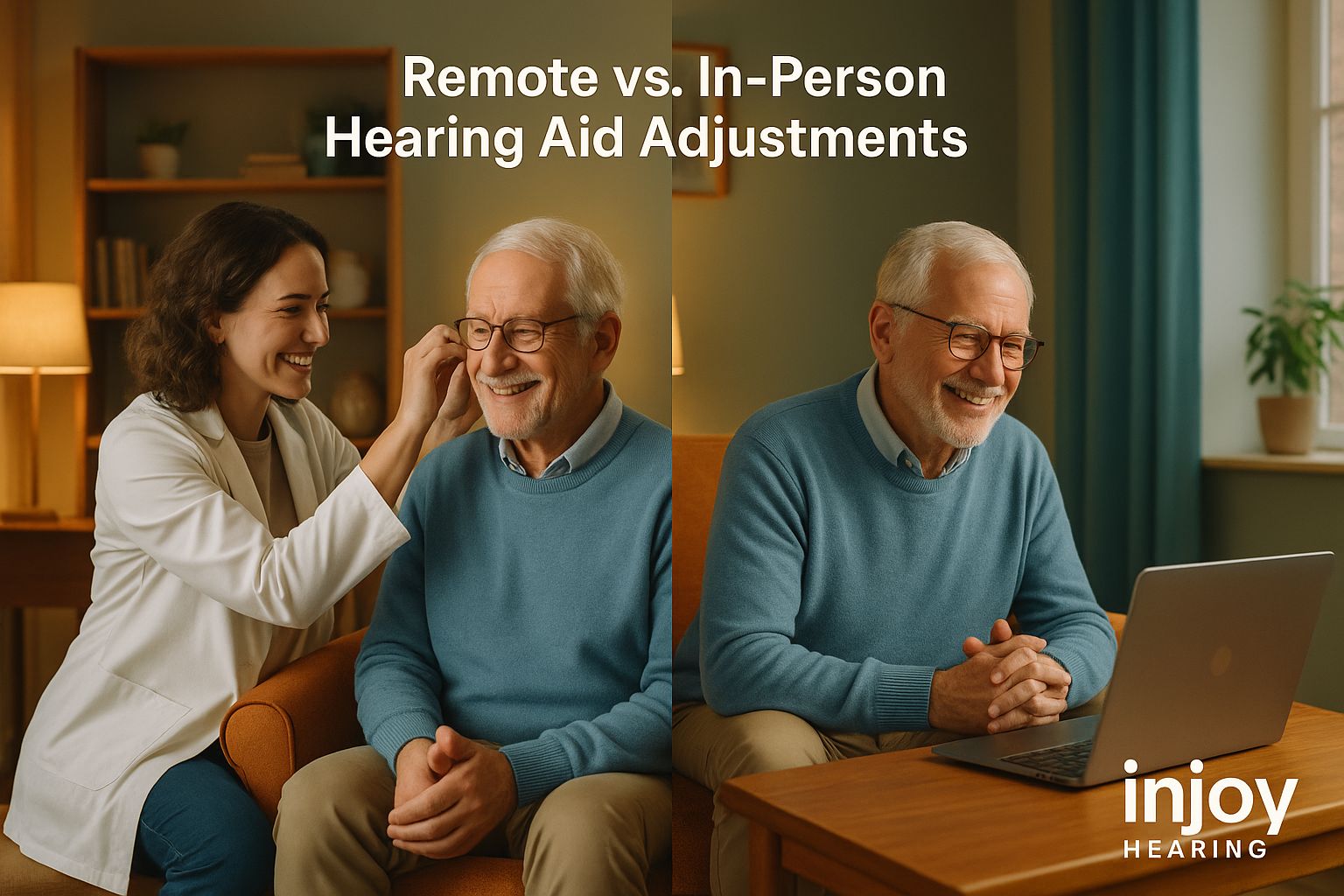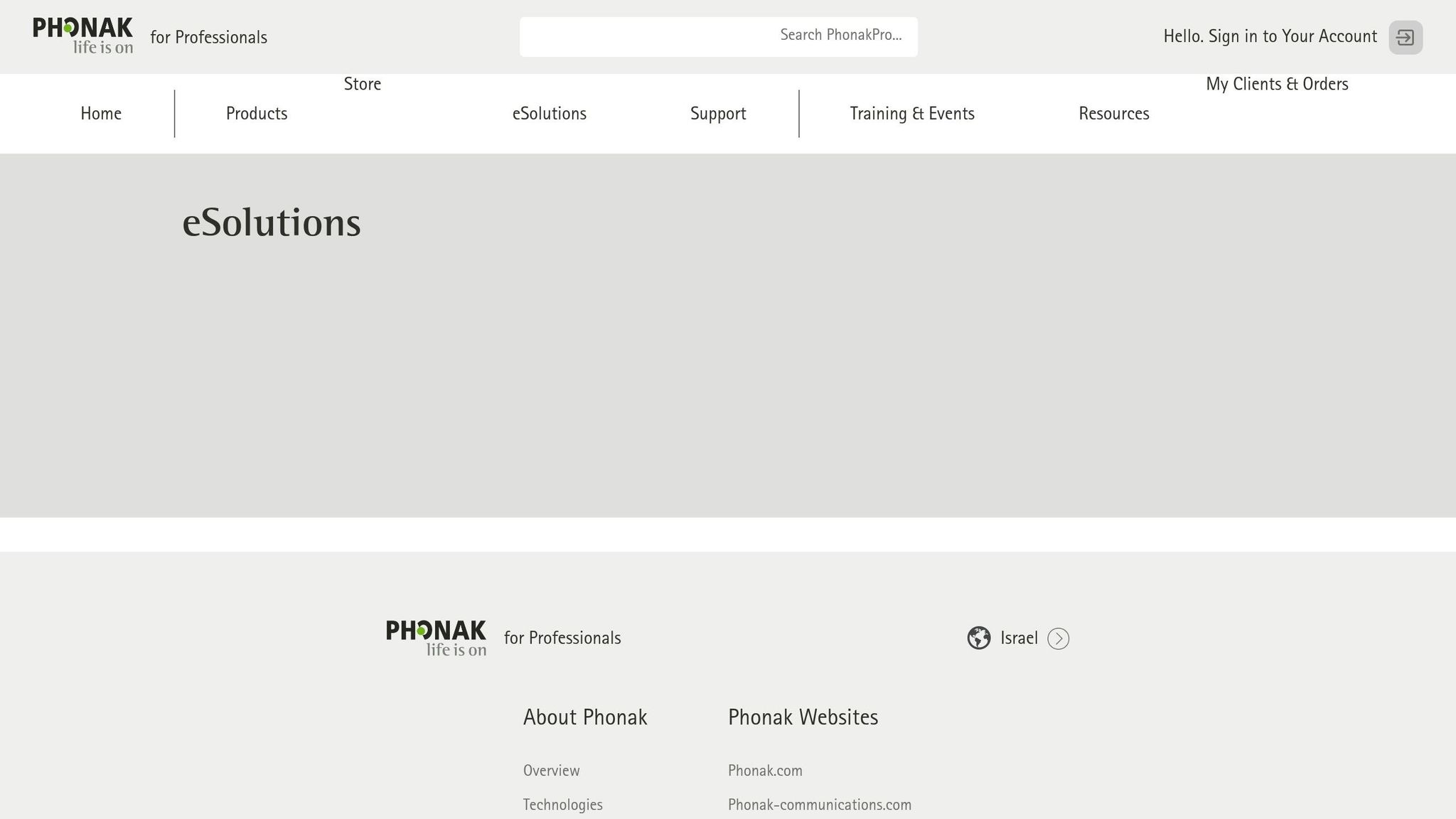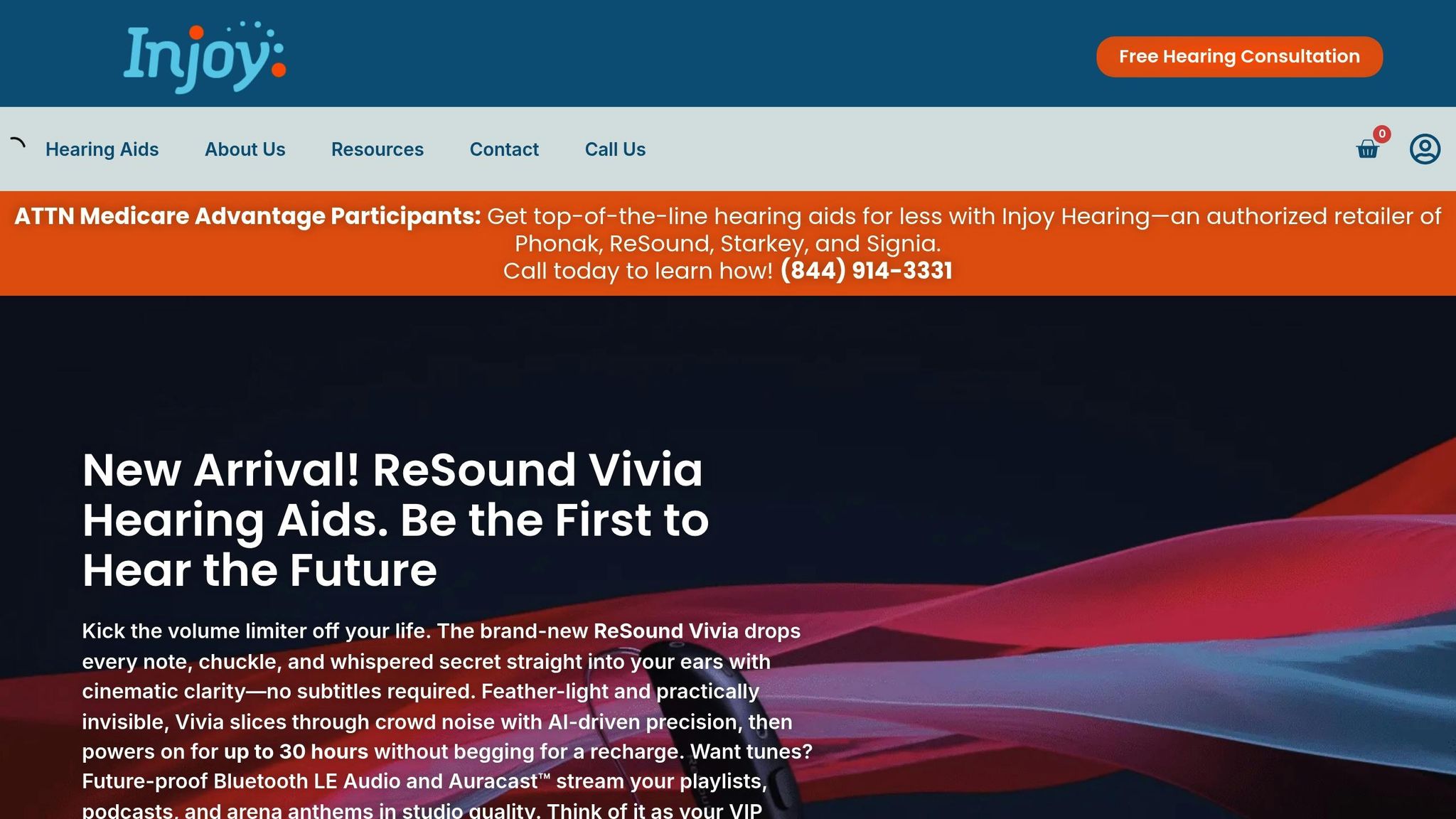
How Do I Get a Hearing Aid?
“WHAT?” You’ve said it so many times your family started a drinking game. The TV volume creeps higher. Your spouse has that look of resigned
Home » Remote vs. In-Person Hearing Aid Adjustments

Choosing between remote and in-person hearing aid adjustments depends on your needs, lifestyle, and comfort with technology. Here’s a quick breakdown:
Quick Overview of Differences:
A hybrid approach – starting with in-person visits for baseline settings and switching to remote for fine-tuning – often works best.
Table of Contents
ToggleRemote hearing aid adjustments let you connect with your audiologist through a digital platform. After installing the app and pairing your hearing aids via Bluetooth, your audiologist can access your device during a session using a stable internet connection. They can review your hearing aid data and make real-time changes to settings like volume, frequency, and noise reduction. These adjustments are based on your feedback during the session, ensuring the sound quality meets your needs. Some platforms even allow audiologists to perform verification measurements through the manufacturer’s software, although this depends on the brand.
For the best experience, make sure your hearing aids are fully charged and that you have a reliable Wi-Fi connection. Sessions are typically conducted in a quiet environment, helping you accurately evaluate any changes made. This straightforward process is the foundation for the benefits discussed below.
Remote adjustments bring a level of convenience that’s hard to ignore. You can access professional hearing care from virtually anywhere – your home, office, or any location with a reliable internet connection. This eliminates the hassle of commuting, taking time off work, or sitting in waiting rooms, making it easier to incorporate care into a busy lifestyle.
These sessions are particularly helpful for individuals with mobility challenges. Whether you use a wheelchair, struggle with driving, or live far from an audiologist’s office, remote options ensure you can still access the care you need. This accessibility became especially important during health emergencies.
Scheduling is another major perk. Remote appointments often offer more flexibility, allowing you to find times that fit your schedule better than traditional office hours. If you’re not satisfied with the initial adjustments, further modifications can be made without requiring another trip to the office. Research shows that remote adjustments deliver results comparable to in-person fittings, with no difference in user satisfaction or hearing aid performance. Plus, if the new settings don’t feel quite right, you can revert to your previous configuration instantly during the session.
While remote adjustments have clear advantages, they also come with limitations. First, you’ll need a compatible smartphone or tablet, a stable internet connection, and a basic understanding of how to use the technology. Not all hearing aid models support remote adjustments, so your device must have Bluetooth capabilities and be supported by the manufacturer.
A poor internet connection can disrupt the session, leading to delays or miscommunication.
Another limitation is the lack of hands-on diagnostic capabilities. Remote sessions can’t address physical issues like earwax buildup, device damage, or other problems that require in-person attention. If your hearing aids need repairs, cleaning, or specialized tests, a remote session won’t suffice. Some users also find it easier to articulate their concerns during face-to-face interactions, which may result in better outcomes.
Lastly, not everyone has the technical skills or equipment needed for remote adjustments, which can limit access for some individuals.

When it comes to hearing aid care, in-person adjustments offer the advantage of hands-on evaluation and immediate problem-solving.
These sessions take place at your audiologist’s office, starting with a conversation about your hearing experiences. Your audiologist will examine both your ears and your hearing aids to identify issues like wax buildup or wear and tear – problems that might go unnoticed during a remote session.
A key part of this process is real-ear verification. Using a tiny microphone placed in your ear, your audiologist measures the actual sound reaching your eardrum. This allows them to fine-tune settings like volume and frequency response with precision.
Additionally, your hearing aids are tested in simulated listening environments. By using specialized equipment, your audiologist can adjust settings in real time while exposing you to various sound scenarios. This ensures your devices are tailored to your hearing loss and fit seamlessly into your daily life.
This hands-on approach lays the groundwork for several benefits, which we’ll explore next.
In-person sessions provide a level of detail and personalization that’s hard to match remotely. For starters, the diagnostic tools available in a clinic – like real-ear measurements and advanced hearing tests – allow for more precise adjustments. Testing in controlled conditions ensures accurate results, making your hearing aids work better for your specific needs.
Face-to-face communication is another advantage. Many people find it easier to explain their hearing challenges and ask questions in person. This open dialogue often leads to solutions that might not surface during a remote session.
These visits also include hands-on troubleshooting and maintenance. Your audiologist can professionally clean your hearing aids, replace worn parts like wax guards or domes, and even make minor repairs on the spot. They’ll also show you how to care for your devices properly, ensuring they last longer and perform better.
Comfort issues are addressed immediately during in-person visits. If your hearing aids feel uncomfortable or don’t fit well, your audiologist can make adjustments or suggest alternative accessories. They’ll also check for any ear health concerns that could impact how your devices function.
While in-person adjustments have clear benefits, they’re not without challenges. The most obvious downside is the time and travel commitment. Appointments usually require scheduling during business hours, which might mean taking time off work or traveling long distances, especially for those in rural areas.
Flexibility is another concern. Audiology offices typically operate on standard schedules, so urgent adjustments might not be available right away. You could end up waiting days or even weeks for an appointment.
Accessibility barriers can also pose challenges. For individuals with mobility issues, transportation difficulties, or health conditions that make travel risky, attending an in-person session may not be practical. This became especially evident during health crises when routine care was harder to access.
Costs can add up, too. Beyond the appointment fee, there are additional expenses like gas, parking, or public transit. If you need frequent adjustments, these small costs can become a burden over time.
Lastly, the clinical environment itself might feel intimidating to some. The formal setting and medical equipment can create anxiety, making it harder to discuss your hearing concerns openly. And even with an appointment, waiting times can be frustrating if your audiologist is running behind schedule, adding to the overall time commitment.
Let’s break down the key differences between remote and in-person adjustments for hearing aids. Each method comes with its own set of strengths and limitations, making them better suited for specific needs and circumstances.
Understanding how these two approaches differ can help you decide which one aligns with your lifestyle and hearing care requirements.
| Aspect | Remote Adjustments | In-Person Adjustments |
|---|---|---|
| Convenience | Accessible anytime from home | Requires scheduled visits during business hours |
| Travel Requirements | None – can be done from anywhere | Travel to clinic, with possible parking or transit costs |
| Speed of Service | Adjustments can be made immediately | Appointments may take days or weeks to schedule |
| Diagnostic Precision | Relies on software-based adjustments | Full diagnostics, including real-ear measurements |
| Physical Examination | No ear or device health checks | Hands-on inspection of ears and hearing aids |
| Maintenance Services | No cleaning or repairs | Includes cleaning, part replacements, and minor repairs |
| Communication Style | Phone, video, or app-based | Face-to-face interaction with audiologist |
| Cost Considerations | No travel-related expenses | Costs for gas, parking, or time off work may apply |
| Accessibility | Great for users with mobility challenges | Can be difficult for those with transportation issues |
| Technical Requirements | Requires a smartphone, computer, and internet | No tech needed from the patient |
Remote adjustments are perfect for tweaking settings like volume or frequency response based on your feedback. However, they can’t address physical problems like earwax buildup, damaged components, or poorly fitting devices.
In contrast, in-person appointments provide a more thorough solution. Audiologists can diagnose and fix multiple issues at once, including problems you might not notice, like worn-out parts or improperly sized domes.
By understanding these differences, you can determine which option suits your needs. Let’s explore when each method works best.
Your choice between remote and in-person adjustments depends on your lifestyle, location, and specific hearing needs.
Go with remote adjustments for quick fixes at the software level. For example, if your hearing aids feel too loud in a noisy restaurant or you’re having trouble hearing phone calls, remote adjustments can often solve these issues in just a few hours. This option is especially convenient for tech-savvy individuals or those with busy schedules.
Remote adjustments are also ideal for people in rural areas where the nearest audiology clinic is far away. If you’ve recently moved and need temporary tweaks before finding a new provider, remote services can fill the gap.
Opt for in-person visits when dealing with physical or complex issues. If your hearing aids are causing discomfort, producing feedback, or if you suspect ear health concerns like wax buildup or infections, an in-person evaluation is essential. New users also benefit from in-person visits during the initial adjustment phase to ensure their devices are properly fitted and functioning.
In-person appointments are particularly important if your hearing aids are older than two years or haven’t been professionally cleaned in a while. These visits ensure both your devices and your ears are in top shape.
A hybrid approach often works best. Many people start with in-person visits to address physical concerns and establish baseline settings, then use remote adjustments for ongoing fine-tuning. This combination offers the best of both worlds: convenience and comprehensive care.
If technology feels overwhelming, stick with in-person sessions. Otherwise, remote adjustments provide a practical and accessible option for managing your hearing aids.

Injoy Hearing combines the ease of remote care with the reassurance of in-person support, offering a range of adjustment services designed to keep your hearing aids performing at their best. By blending advanced technology with tailored assistance, they ensure users can maintain optimal hearing, no matter their preferred method of adjustment.
It all starts with a free consultation to help identify the best devices and adjustment methods for your needs. This initial step lays the groundwork for long-term success in managing your hearing care.
From there, Injoy Hearing offers remote fitting and activation appointments. These sessions use your hearing test results and personal feedback to program and fine-tune your hearing aids right from the start. Whether you prefer the convenience of remote appointments or the hands-on approach of in-person visits, they’ve got you covered.
Their extended warranties provide reassurance by covering manufacturer defects and technical issues that may arise. Plus, their loss and damage protection ensures you’re covered for accidents, no matter how you choose to manage your adjustments.
For ongoing care, Injoy Hearing’s team is always available to help. Whether it’s a quick remote tweak or a detailed in-person evaluation, they’re committed to optimizing your hearing experience. With cutting-edge technology backing their services, every adjustment is tailored to your unique needs.
Injoy Hearing’s devices are packed with advanced technology, making remote adjustments seamless and effective. Here’s a closer look at some standout features:
Injoy Hearing offers several advanced models that work seamlessly with remote adjustment technology. Here are some top options:
All these models support both remote and in-person adjustments, giving you the flexibility to choose what works best for you. Ultimately, the decision comes down to your personal preference, as these devices are designed to perform well in any setting.
Selecting between remote and in-person hearing aid adjustments depends on your lifestyle, comfort with technology, and specific hearing needs. There’s no universal solution, so it’s important to weigh your options carefully.
Both remote and in-person adjustments offer distinct advantages, and the right choice often comes down to your unique situation.
Remote adjustments are perfect for those who value convenience. If you’re juggling a busy work schedule, managing family responsibilities, or living far from your hearing care provider, remote options can save you time and effort. They work well for minor tweaks, especially if you can clearly explain your needs during a phone or video call.
In-person adjustments, on the other hand, are better suited for more complex issues. For example, physical exams can identify problems like earwax buildup or improper fit – issues that remote consultations might overlook. They’re also ideal for major programming changes or when it’s difficult to communicate your exact hearing challenges.
Your comfort with technology is another factor. If you’re confident using smartphone apps and handling basic troubleshooting, remote adjustments may feel natural. But if you prefer face-to-face interactions or hands-on guidance, in-person visits might give you more reassurance.
The severity of your hearing loss also plays a role. Mild to moderate cases often respond well to remote fine-tuning, while more complex situations may require the detailed evaluation that only an in-person visit can provide. Cost and time are other considerations – remote adjustments often save money and eliminate travel time, while in-person visits may involve scheduling, commuting, or taking time off work.
By keeping these factors in mind, Injoy Hearing makes it easier to decide which option suits you best.
Injoy Hearing knows that choosing between remote and in-person adjustments can feel like a big decision. That’s why they start every relationship with a free consultation to understand your specific needs, lifestyle, and preferences.
During this consultation, their team takes the time to evaluate your daily routine, comfort with technology, and the complexity of your hearing challenges. This personalized approach ensures that your hearing aid adjustments are tailored to deliver the best possible results.
Injoy Hearing also offers flexibility. Many users prefer starting with in-person visits to establish a baseline before switching to remote adjustments for quick updates. Others combine regular in-person check-ups with remote services for added convenience.
Their advanced hearing aids, including models from Phonak, ReSound, Starkey, and Signia, are designed to work seamlessly with both adjustment methods. Whether you choose the Phonak Audéo Sphere Infinio I90 or the ReSound Vivia 9, you’ll have the freedom to adapt your care approach as your needs evolve.
Ready to take the next step? Visit Injoy Hearing to schedule your free consultation and find the adjustment method that helps you hear your best.
To make the most of remote hearing aid adjustments, you’ll need a few essentials: compatible hearing aids that allow remote programming, a stable internet connection, and a smartphone or device with the required app installed. Knowing your way around a smartphone can make the setup and app navigation much easier.
For a smooth experience, a Wi-Fi connection with at least 1 Mbps speed is recommended. Your hearing care provider will also need access to the right platform to tweak your device settings remotely. If you’re unsure whether your hearing aids are compatible, it’s a good idea to check with your provider or refer to the user guide for your device.
Choosing between in-person and remote hearing aid adjustments comes down to your personal needs and daily routine.
If you’re new to hearing aids, need a detailed evaluation, require physical maintenance, or are dealing with noticeable changes in your hearing, in-person adjustments are the way to go. These appointments provide hands-on care and allow for a more tailored approach to your hearing health.
Meanwhile, remote adjustments are perfect for quick follow-ups or minor tweaks. They’re a time-saver and can be done right from your home, making them a great option for those with busy schedules or who value flexibility. Many users find that combining both methods works best – starting with in-person visits for initial fittings and switching to remote sessions for ongoing fine-tuning.
At Injoy Hearing, we provide both in-person and remote options to match your preferences. Plus, our advanced hearing aids come equipped with features like AI-powered noise reduction and Bluetooth connectivity, ensuring precise adjustments no matter how you connect with us.
Many of today’s hearing aids come equipped with remote adjustment capabilities, giving users the freedom to fine-tune their devices without needing to visit a clinic. Popular models such as the Phonak Audéo Lumity L90, Signia Pure Charge&Go BCT 7IX, ReSound Vivia 9, and Starkey Genesis AI 24 offer this convenient feature. Using dedicated apps or remote programming tools, these devices allow you to make adjustments right from home.
At Injoy Hearing, we focus on offering advanced hearing aids packed with features like AI-powered noise reduction, Bluetooth connectivity, and customizable sound settings. With remote adjustments, personalizing your hearing experience has never been easier, no matter where life takes you.

“WHAT?” You’ve said it so many times your family started a drinking game. The TV volume creeps higher. Your spouse has that look of resigned

If a noisy restaurant feels like a boss fight, you’re not alone. The real showdown is Signia Pure Charge&Go IX vs Phonak Sphere Infinio. One

If you’ve ever cranked up the TV until the dog gave you side‑eye, you’ve probably Googled cheap hearing aids. The price tags look friendly. The

If choosing a hearing aid brand feels like speed-dating for your ears, you’re not alone. Every company claims to have the clearest sound, smartest AI,
Injoy specializes in crafting custom Phonak hearing aid solutions tailored to the unique hearing needs of our patients. With a team recognized as the best in the business and decades of experience in helping people nationwide, we’re dedicated to improving your hearing and, consequently, enhancing your quality of life.
To start your journey towards better hearing with confidence, Injoy is proud to offer a 30-day risk-free hearing aid trial. This allows you to experience the difference our Phonak hearing aids can make, ensuring they meet your expectations and fit your lifestyle perfectly.
Improve your hearing and improve your life today by contacting Injoy to learn more about our risk-free trial!

Need hearing aids? Explore our range of hearing aids and discover the best option for your lifestyle and Unique Hearing Needs.
Are you a current patient with us? We're here to help with any adjustments, repairs, or support you may need.